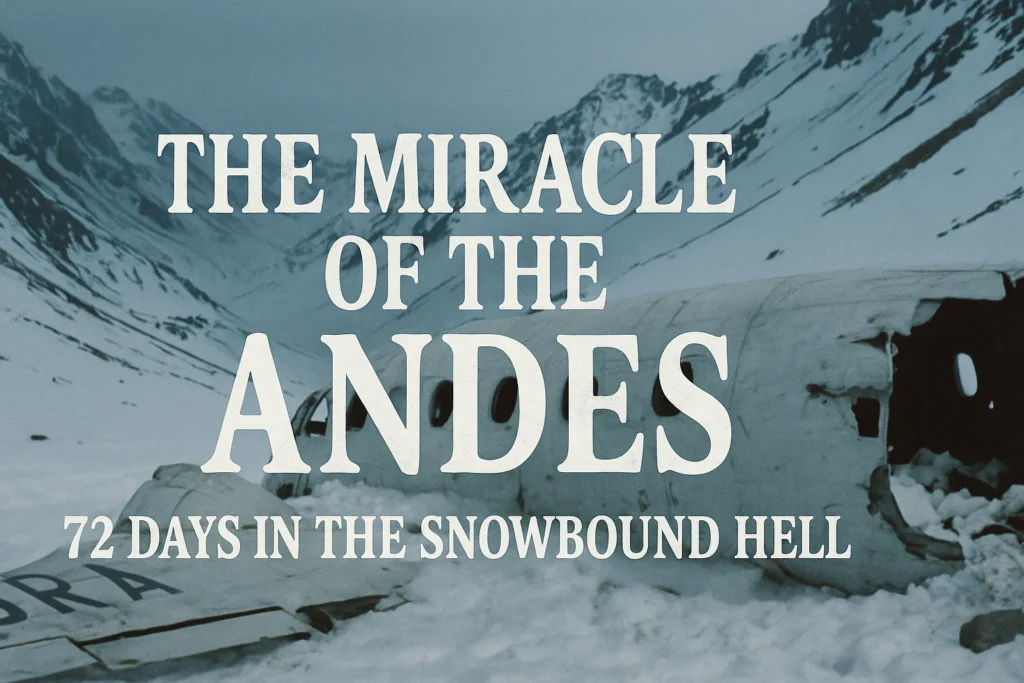Chapter 1: The Flight That Never Landed
Friday, October 13, 1972, should have been an ordinary day for the Old Christians Club rugby team. The chartered Fairchild FH-227D rumbled down the runway at Carrasco International Airport, carrying 45 souls toward what should have been a routine one-hour hop across the Andes to Santiago, Chile. Among the passengers: 19 young rugby players, their friends and family, and a crew of five. The mood was light—jokes about Friday the 13th were exchanged as the plane climbed into cloudy skies.
The Final Moments Before Impact
- 1:30 PM: Pilot reports entering Andes turbulence
- 2:18 PM: Mistaken turn toward Curicó instead of Planchón pass
- 2:30 PM: “We’re passing Curicó now… how much longer to Santiago?” (last radio transmission)
- 2:33 PM: Right wing clips mountain peak at 13,800 feet
“The plane tilted violently left,” survivor Roberto Canessa recalled. “Then we were falling, seats ripping from the floor, people screaming prayers.”
Chapter 2: The First Night in Hell
The Immediate Aftermath
- Crash Site: Glacier at 11,710 feet (-30°C/-22°F at night)
- Initial Death Toll: 12 on impact, 5 more by morning
- Survivors’ Condition: Broken bones, internal bleeding, altitude sickness
Improvised Shelter:
The intact fuselage became their refuge—a frozen metal coffin where:
✓ Seats became beds
✓ Luggage became walls
✓ Broken electronics became tools
“We covered the windows with snow to keep warmth in… and the horror out.”
— Nando Parrado, survivor
Chapter 3: The Unthinkable Decision
Day 10: Starvation Sets In
| Food Source | Calories/Day |
|---|---|
| Chocolate bars | 200 (ran out Day 5) |
| Wine | 50 (gone by Day 8) |
| Snow water | 0 |
| The Dead | 500-800 |
“We discussed it for three days,” said Carlitos Páez. “Either we lived with the dead, or we died with them.”
The Ethical Debate
- Medical student Canessa explained protein necessity
- Catholic players held secret communion services
- Agreement: Only those already gone would be “used”
Chapter 4: The Impossible Journey
The Expedition Team
- Nando Parrado (head trauma survivor)
- Roberto Canessa (medical student)
- Antonio “Tintin” Vizintín (turned back)
Their Gear:
✘ No climbing equipment
✘ No cold-weather gear
✔ Patched-together sleeping bag (seat covers)
✔ Human-flesh rations (6 lbs for 10-day trek)
The Climb From Hell
- Day 1: Ascend 15,000-ft peak (discovered they were west of Argentina)
- Day 3: Find airplane tail—radio dead but retrieve batteries
- Day 7: Spot green valleys (still 45 miles away)
- Day 10: Encounter Chilean arriero Sergio Catalán
“¡Vienen de un avión! ¡Somos uruguayos!” (“We come from a plane! We’re Uruguayans!”) — Parrado’s first words to Catalán
Chapter 5: The Rescue That Defied Odds
December 22-23, 1972
- Two helicopter teams scramble
- Whiteout conditions nearly abort mission
- First chopper reaches crash site at dusk
The Survivors’ Condition After 72 Days:
✓ Average weight loss: 45 lbs
✓ 3rd-degree frostbite on all
✓ Blood oxygen levels at 50% normal
“Seeing that first helicopter… I didn’t know whether to laugh, cry, or faint.” — Eduardo Strauch
Chapter 6: The Science of Survival
Medical Miracles
| Condition | Survival Adaptation |
|---|---|
| Hypothermia | Metabolic slowdown (35°C core temp) |
| Starvation | Ketosis after 3 days (fat burning) |
| Altitude sickness | Increased red blood cell production |
Shocking Fact: Their bodies recycled muscle tissue before attacking organs—nature’s failsafe.
Chapter 7: The Legacy
Psychological Impact
- Survivors Today: 16 still alive (2024)
- Common Traits: High resilience, spiritual depth
- PTSD Management: Annual reunions at crash site
Lessons for Survival Training
✓ Positive delusions help (“We’re getting out tomorrow”)
✓ Small goals prevent despair (“Just make it to sunset”)
✓ Social bonds trump individual strength
Why This Story Still Matters
The Andes survivors represent the ultimate test of human will. Their ordeal answers profound questions:
- How much can the body endure? (Far more than we think)
- What lines would you cross to live? (The answer surprises you)
- Does hope need evidence? (No—it creates its own)
As survivor José Luis “Coche” Inciarte put it: “The mountains taught us that death is easy. Living—that’s the hard part.” Their 72-day battle against impossible odds remains history’s greatest testament to the indomitable human spirit.



